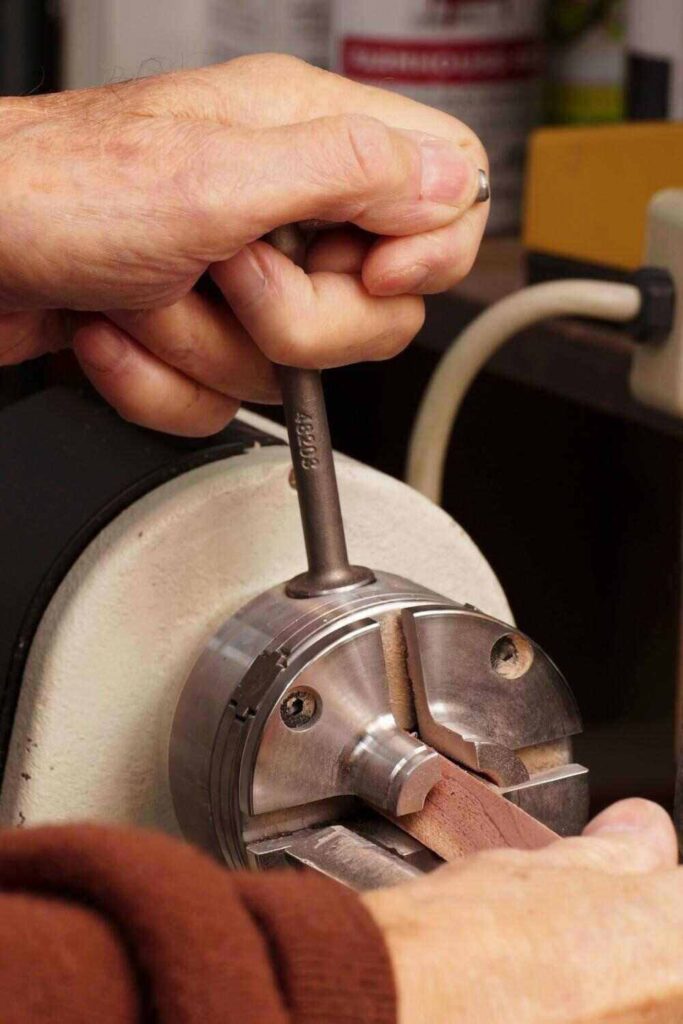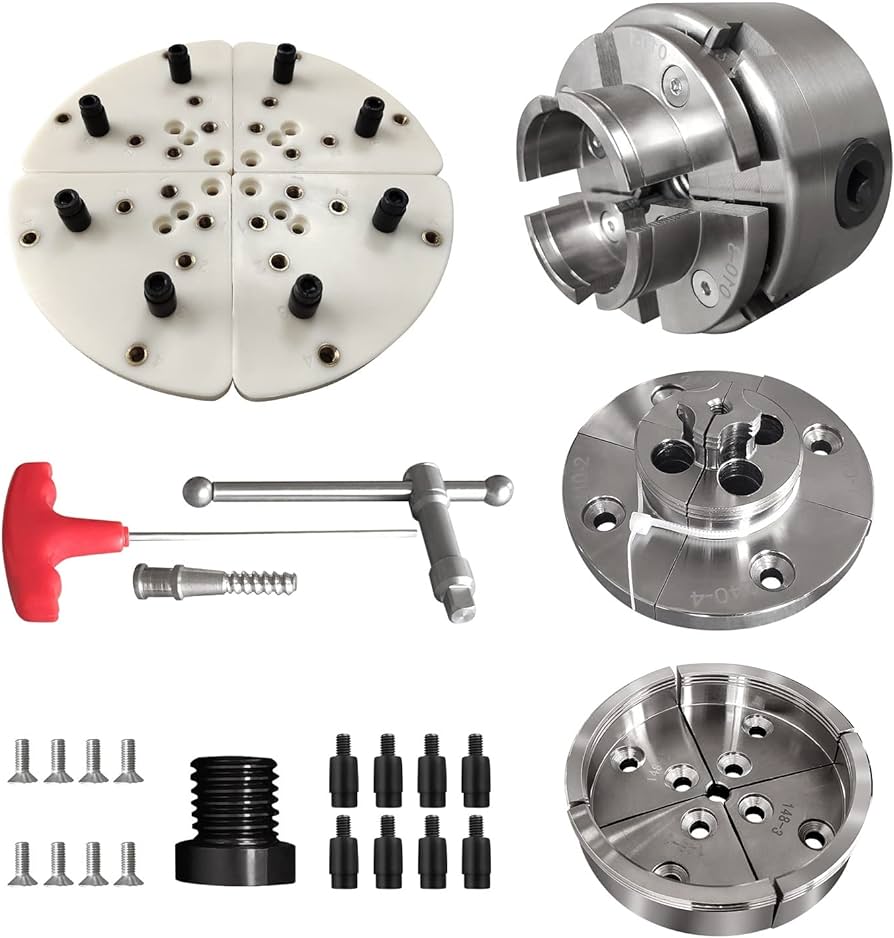So, you’ve got yourself a wood lathe and now you’re wondering, “What wood lathe chuck should I buy?” Well, my friend, you’ve come to the right place! Choosing the right chuck for your lathe is like finding the perfect tool for the job. It can make all the difference in your woodworking experience.
Now, I know you might be thinking, “What in the world is a wood lathe chuck?” Don’t worry, I’ve got your back! A wood lathe chuck is a device that holds your wood securely in place while you shape it with your lathe. It’s like a trusty friend that keeps your work steady and stable.
But here’s the thing, not all wood lathe chucks are created equal. There are different types and sizes to choose from, depending on your needs. So, let’s dive into the world of wood lathe chucks together and find the perfect one for you. Are you ready? Let’s go!
Looking to buy a wood lathe chuck? Consider these important features before making your decision:
1. Jaw Size: Choose a chuck with adjustable jaws to accommodate different sizes of wood.
2. Grip Strength: Look for a chuck with strong gripping power to securely hold the wood.
3. Easy Installation: Opt for a chuck that is easy to install and remove from the lathe.
4. Durability: Check for a chuck made from high-quality materials for long-lasting use.
5. Versatility: Consider a chuck that offers different mounting options for added versatility in your woodworking projects.
Remember to compare these features when choosing the right wood lathe chuck for your needs.

What Wood Lathe Chuck Should I Buy?
Choosing the right wood lathe chuck can make a significant difference in your woodworking experience. With so many options available on the market, it can be overwhelming to know which one to buy. In this article, we will guide you through the factors to consider when selecting a wood lathe chuck and provide recommendations based on your specific needs and preferences. Whether you are a beginner or a seasoned woodworker, this article will help you make an informed decision.
Factors to Consider
When choosing a wood lathe chuck, several factors need to be taken into consideration. Let’s delve into each of these factors:
Chuck Size
The chuck size refers to the diameter of the opening in the chuck that holds the wood. It is crucial to choose a chuck size that matches your lathe’s spindle size. Most wood lathes have either a 1″ x 8TPI or a 3/4″ x 16TPI spindle thread size. Ensure that the chuck you select is compatible with your lathe’s spindle size to ensure a secure and stable grip on the wood.
Moreover, consider the maximum diameter of the wood you plan to turn. If you primarily work on smaller projects, a chuck with a smaller capacity will suffice. However, if you anticipate working on larger bowls or spindles, opt for a chuck with a larger maximum diameter capacity.
Chuck Type
There are various types of wood lathe chucks available, each suiting different turning projects:
- Four-Jaw Self-Centering Chuck: This type of chuck is popular among woodturners due to its versatility. It consists of four jaws that can be adjusted independently, allowing for precise centering of the wood. This chuck is ideal for workpieces that may not have perfect centers.
- Three-Jaw Scroll Chuck: The three-jaw scroll chuck is the most common type of chuck. It provides quick and easy adjustment, as all three jaws move simultaneously. This chuck is suitable for most turning projects and offers good value for money.
- Specialty Chucks: There are specialty chucks available for specific projects. For example, a pin chuck is designed to hold small dowels or delicate pieces, while a vacuum chuck utilizes suction to hold the wood securely in place. Consider any specialized projects you may undertake and choose a chuck accordingly.
Jaw Size and Type
The size and type of jaws on a wood lathe chuck determine the range of wood sizes and shapes it can hold. Larger jaws can accommodate larger workpieces, while smaller jaws are more suitable for delicate turning projects. Some chucks offer interchangeable jaws, allowing greater versatility.
Additionally, consider the type of jaws that come with the chuck. Smooth jaws are ideal for holding finished pieces without leaving any marks, while serrated jaws provide a better grip on rough or unfinished wood.
Build Quality and Durability
Investing in a high-quality wood lathe chuck is essential for long-term durability and performance. Look for chucks made from robust materials such as steel or cast iron to ensure stability and longevity. Check customer reviews and ratings to gauge the quality and reliability of the chuck before making a purchase.
Furthermore, consider the ease of use and maintenance. Look for chucks with smooth jaw adjustments, user-friendly mechanisms, and simple cleaning requirements to enhance your woodworking experience.
Price and Budget
Wood lathe chucks can vary significantly in price, depending on their features, brand, and build quality. It is important to set a budget for your chuck purchase and consider the value for money offered by different options. While it can be tempting to opt for the cheapest option available, prioritize the overall quality and suitability for your turning projects.
Consider any additional expenses that may be incurred, such as purchasing extra jaws or accessories, when factoring in the cost of the chuck. Balancing your budget with your requirements will help you make a well-informed decision.
Key Takeaways: What Wood Lathe Chuck Should I Buy?
- Consider the type of projects you plan to work on with the wood lathe chuck.
- Ensure that the chuck is compatible with your lathe’s spindle size.
- Look for a chuck with a wide range of jaw sizes for versatility.
- Consider the material and construction quality of the chuck for durability.
- Read customer reviews and ratings to get insights from other woodworkers.
Frequently Asked Questions
Are you in the market for a new wood lathe chuck but not sure which one to buy? Look no further! Here are some common questions and answers to help guide you in choosing the perfect wood lathe chuck for your needs.
1. What factors should I consider when choosing a wood lathe chuck?
When selecting a wood lathe chuck, consider the size, type, and mounting options. The size of the chuck should be compatible with your lathe’s spindle size. Different chucks are designed for specific types of turning, such as bowl turning or spindle turning, so choose the one that best matches your woodworking projects. Additionally, consider the mounting options available for the chuck, such as threaded or tapered mounts, to ensure it can be securely attached to your lathe.
Furthermore, it’s essential to think about the quality and reputation of the brand. Look for trusted manufacturers known for producing durable and reliable wood lathe chucks. Reading reviews and seeking recommendations from fellow woodturners can also provide valuable insights.
2. What are the advantages of a self-centering wood lathe chuck?
A self-centering wood lathe chuck is designed to automatically center the workpiece when clamped, saving you time and effort. It features jaws that move in unison, ensuring an even and balanced grip. This type of chuck is especially useful when working with round or symmetrical workpieces, as it eliminates the need for manual adjustment to achieve centering.
Additionally, a self-centering wood lathe chuck allows for quick and easy adjustments, making it ideal for projects that require frequent changes. It provides a secure grip on the workpiece, minimizing the risk of slippage and accidents, which is crucial for safe and efficient woodturning.
3. Should I choose a four-jaw or three-jaw wood lathe chuck?
The choice between a four-jaw or three-jaw wood lathe chuck depends on your specific needs and preferences. A three-jaw chuck is commonly used as it provides a more balanced and centered grip on symmetrical workpieces. It is easier to use and offers faster adjustments due to its self-centering feature.
However, a four-jaw chuck provides more versatility, allowing you to clamp irregularly shaped or non-symmetrical workpieces more securely. While it requires manual adjustment to center the workpiece, it offers greater control and stability for complex turning projects.
4. Can I use different-sized jaws on the same wood lathe chuck?
Yes, many wood lathe chucks offer interchangeable jaws, allowing you to change the gripping capacities without needing to purchase a new chuck. These interchangeable jaws come in various sizes and designs to accommodate different workpiece dimensions and shapes.
Having different-sized jaws for your wood lathe chuck provides flexibility and convenience, enabling you to tackle a wide range of turning projects with a single chuck. Before purchasing additional jaws, make sure they are compatible with your specific lathe chuck model. Check the manufacturer’s specifications or consult with a knowledgeable woodturning supplier for assistance.
5. What are the benefits of investing in a high-quality wood lathe chuck?
Investing in a high-quality wood lathe chuck offers several benefits. Firstly, it ensures better accuracy and precision in your turning projects, as top-notch chucks are built with tighter tolerances, reducing any wobbling or imbalances. This results in cleaner cuts and smoother finishes on your woodwork.
A high-quality wood lathe chuck also provides enhanced durability, allowing it to withstand the rigors of woodturning without wearing out quickly. It offers better gripping strength, minimizing the risk of slippage or accidents while working. Additionally, premium chucks often come with improved features, such as better jaw designs or advanced clamping mechanisms, providing enhanced versatility and ease of use.

Summary
Picking the right wood lathe chuck doesn’t have to be tricky. First, consider the type of work you’ll be doing. If you’ll be working on different projects, a four-jaw independent chuck is flexible. But if you’re focusing on bowls or platters, a scroll chuck is more suitable. Make sure to check the chuck’s size compatibility with your lathe, and don’t forget about the thread size. Remember, safety is key, so choose a chuck that is easy to adjust and securely holds the wood in place. Don’t hesitate to seek advice or read reviews before making your final decision.
Takeaway
Picking the right wood lathe chuck is important for your woodworking projects. Think about the type of work you’ll be doing, check the compatibility with your lathe, and remember to consider safety. Don’t rush the decision – do your research and ask for advice!
